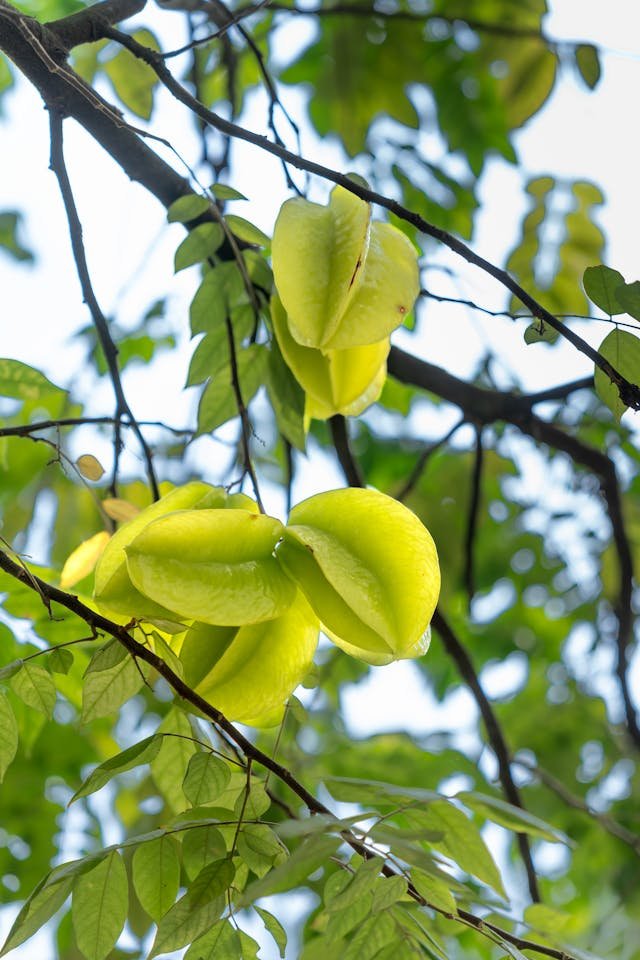Have you ever come across a fruit so unique it looks like a star when sliced? Meet the star fruits, also known as carambola! Native to Southeast Asia, this tropical gem is not only visually stunning but also packed with nutrients. Whether you’re new to star fruits or a long-time fan, let’s explore everything you need to know about this tropical wonder.
What Is Star Fruit?
Star fruits (Averrhoa carambola) is a juicy, golden-yellow fruit that gets its name from its distinct star-shaped cross-section. Its flavor can range from sweet to tangy, depending on the variety and ripeness. While it thrives in tropical climates like those in Asia, the Caribbean, and Central America, it’s becoming increasingly popular worldwide.
Nutritional Benefits of Star Fruit: A Hidden Tropical Gem
When it comes to tropical fruits, star fruits (carambola) often flies under the radar. With its vibrant yellow color, star-shaped slices, and unique sweet-tangy flavor, it’s a feast for both the eyes and taste buds. But did you know it’s also packed with essential nutrients? Let’s uncover the nutritional benefits of this exotic fruit and why it deserves a spot in your diet.
1. Low in Calories, Big on Flavor
If you’re watching your calorie intake, star fruit is a fantastic choice. One medium-sized fruit has only about 30 calories. It’s the perfect guilt-free snack to satisfy your cravings without tipping the calorie scale.
2. Rich in Vitamin C
Star fruits is a vitamin C powerhouse, providing over 50% of your daily recommended intake in just one fruit. This essential nutrient:
- Boosts your immune system.
- Protects against free radicals with its antioxidant properties.
- Promotes healthy skin by enhancing collagen production.
3. A Good Source of Fiber
Fiber is crucial for digestion, and star fruits offer a healthy dose of it. One medium fruit contains approximately 3 grams of dietary fiber, which:
- Aids in digestion and prevents constipation.
- Helps manage blood sugar levels.
- Keeps you feeling full, which can support weight management.
4. Loaded with Antioxidants
Star fruits contain various antioxidants, such as flavonoids and polyphenols, which help neutralize free radicals. These antioxidants:
- Reduce inflammation.
- Protect cells from oxidative stress.
- Lower the risk of chronic diseases like cancer and heart disease.
5. Provides Essential Minerals
Star fruit is a good source of important minerals like:
- Potassium: Helps regulate blood pressure and supports heart health.
- Magnesium: Plays a role in muscle and nerve function, as well as bone health.
- Copper: Supports red blood cell production and immune function.
6. Low in Sugar
Compared to many other fruits, star fruits are low in sugar, making it a great option for people with diabetes or those trying to cut back on sugary snacks. Its glycemic index is low, so it won’t cause blood sugar spikes.
7. Hydrating and Refreshing
With over 90% water content, star fruits is highly hydrating. Eating it is a tasty way to replenish lost fluids, especially on a hot day or after exercise.
8. A Natural Source of Iron
Iron is essential for red blood cell production and preventing anemia. While star fruits may not have high iron levels, its rich vitamin C content enhances iron absorption from other foods.
Nutritional Breakdown of Star Fruit (Per 100g)
Here’s what you get in approximately 100 grams of star fruits:
- Calories: 31
- Carbohydrates: 6.7g
- Fiber: 2.8g
- Vitamin C: 34mg (57% DV)
- Potassium: 133mg
- Magnesium: 10mg
Star fruit isn’t just a tropical delight—it’s a nutritional powerhouse that can benefit your body in multiple ways. Low in calories, rich in vitamins, and packed with fiber, it’s a smart addition to any diet. So next time you see star fruit at the store, don’t hesitate to grab a few and enjoy the taste of tropical health!
How to Enjoy Star Fruit
One of the best things about star fruits is its versatility. Here are a few ways to enjoy it:
1. Raw and Fresh: Slice it up and eat it as a snack—it’s juicy and refreshing!
2. In Salads: Add star-shaped slices to fruit or green salads for a tropical twist.
3. Juices and Smoothies: Blend it with other fruits for a flavorful drink.
4. As a Garnish: Use it to decorate cocktails, desserts, or even cakes.
5. Cooking: Add it to curries or stews for a tangy punch.
Quick tip: If the edges of the star fruits feel tough, trim them slightly before slicing.
Potential Risks to Know: A Word of Caution
While star fruits is healthy for most people, it contains compounds called oxalates. This can be harmful to individuals with kidney issues, as their bodies may struggle to process these compounds. If you have kidney disease, it’s best to avoid star fruits or consult your doctor before eating it.
How to Pick and Store Star Fruit
Want the best-tasting star fruits? Here’s how to pick it:
- Look for fruits that are bright yellow with slight green edges.
- Avoid any that are overly brown or wrinkled.
- Store ripe star fruits in the refrigerator for up to a week. If they’re not fully ripe, leave them at room temperature to ripen naturally.
The Cultural Significance of Star Fruit
In many Asian and Caribbean cultures, star fruits holds special value. It’s often used in traditional medicine to treat ailments like fever and digestive issues. Beyond its health benefits, it symbolizes good luck and is a popular offering during celebrations.
Final Thoughts
Star fruits is more than just a pretty face—it’s a nutrient-packed, versatile fruit that deserves a spot in your diet. Whether you’re snacking on it fresh or using it in recipes, star fruit is a delightful way to add a tropical touch to your meals.
References
1. USDA FoodData Central: Nutritional Profile of Star Fruit
2. National Kidney Foundation: Star Fruit and Kidney Health
3. Healthline: Health Benefits of Star Fruit
4. USDA FoodData Central: Nutritional Data on Star Fruit
5. National Institutes of Health: Vitamin C and Its Benefits
6. Healthline: Star Fruit Nutrition Facts
By learning more about this tropical gem, you can enjoy its unique taste and health benefits while staying mindful of any risks. So, why not grab a star fruit on your next grocery run and try it out?





